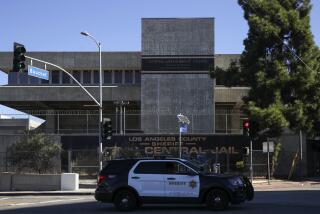To Stem Jail Overcrowding, Put the Courts on Overtime
Los Angeles County is facing a systemwide criminal-justice crisis. Public safety and all aspects of law enforcement here are in jeopardy because of the combination of overcrowded jails and inadequate judicial resources. Without an immediate and effective increase of judicial officers, the early release of prisoners and breakdown of court processes are inevitable.
Our jail overcrowding is staggering. Los Angeles’ system is the largest county jail system in America, confining more prisoners than the systems of 46 states, based on a 1986 study by the National Institute of Corrections. The County Jail system, which has a design capacity of 13,000 inmates, now confines more than 22,000.
The hub of this system is the Men’s Central Jail, which confines more people than any other institution of its kind in the free world, according to the National Institute. A class-action lawsuit filed in 1975 by the ACLU Foundation of Southern California resulted in a federal court order requiring certain basic conditions in the jail--including a mattress and bed or bunk for each inmate, at least 2 1/2 hours of outdoor or other recreation per week, a minimum of 15 minutes to eat, clean garments twice a week, and chairs or benches for inmates in holding cells.
The sheriff has made good-faith attempts to comply with these orders, implementing numerous programs including expansion of existing facilities and increased work-release programs. However, the dramatic increase in the jail’s population--now 8,000 in a facility designed for 5,400--has rendered compliance impossible. Each night hundreds of incoming prisoners are without beds.
Three of four possible solutions to this overcrowding offer questionable results:
First, law-enforcement agencies can stop arresting people accused of crimes. The county already limits jail intake by routinely citing and releasing more than 90% of people arrested for misdemeanors. To go further and arbitrarily stop arrests would jeopardize the public.
Second, prisoners can be released early. Plans already exist for early release if the jail system’s population exceeds 24,000. However, this is not an acceptable option for the source of the greatest overcrowding--defendants accused of serious crimes.
Third, more jails can be built. Even the county’s current jail construction program to add almost 7,000 beds by 1992 will not keep up with the mushrooming jail population. Jail construction is a time-consuming and expensive option.
One real solution exists. The only viable option to control overcrowding is to increase judicial resources in order to move each criminal case more quickly through the county courts.
One such effort was the 90-day Criminal Crash Program, instituted through direct discussions with the court from July 15 through Oct. 15. It provided more criminal courts by converting courts commonly allocated for civil cases to criminal cases.
The initial results of the program show a measurable effect on reducing jail populations. Although 43 courts were to be converted for criminal use, because of judicial vacations and other resource problems, Superior Court records indicate that the actual increase was fewer than 20. Nevertheless, records from the first two months demonstrate that the shift saved the equivalent of a 100-man jail--a significant initial effort.
A continuing Crash Program is not the total answer. During the program the usual waiting time for civil trials increased from 4 years and 10 months to 5 years. In addition, most available data prove that Los Angeles County judges already handle extremely high caseloads and process litigation as effectively as, or more effectively than, those in other counties.
So long-term improvements should be accomplished by a united county seeking emergency state legislation providing for additional judges. But the crisis exists today; jail overcrowding cannot wait five to seven years for new courthouses. County officials are now prepared to provide additional judicial officers and attorneys.
The courtroom shortage can be met only through two-shift Superior Court operations. Night court has already been endorsed by the sheriff, the district attorney and the public defender. Indeed, many of those involved in the present night court pilot program say that it is more effective than normal daytime processing.
Night court, the temporary elevation of Municipal Court judges, the use of commissioners, greater control of continuances, and all other available strategies must be utilized to move more cases through the courts more quickly. Our looming crisis in criminal justice will not be contained unless the Superior Court takes a leadership role in implementing these solutions.
More to Read
Sign up for Essential California
The most important California stories and recommendations in your inbox every morning.
You may occasionally receive promotional content from the Los Angeles Times.










